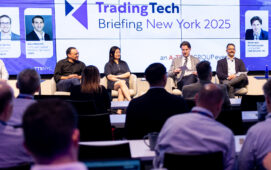Emilio Mercado is director, financial services product & strategy at the Collaborative Software Initiative. IntelligentTradingTechnology.com talked to him about the recent release of MDAL – The Market Data Abstraction Layer – which has a goal of providing a single API to access market data across an enterprise, avoiding vendor lock-in.
Q: Why is MDAL needed?
A: In today’s trading environment, business units are dependent on access to market data to meet all aspects of their application functional requirements. Business lines access market data services using fundamentally different third-party software packages that are often supported by separate distribution infrastructures.
To meet their specific content requirements, business units must spend valuable resources on code customisation for various market data vendors. Over the years, the business requirements of all groups combined with the available solutions has resulted in firms relying on multiple versions of different third-party APIs. MDAL offers a solution that satisfies all business requirements by providing a uniform programmatic access method to all market data, irrespective of data provider.
MDAL is designed to provide the financial community with the ability to seamlessly subscribe and publish to various market data services using a simplified and singular method which does not tie the business or software to a specific vendor. It allows developers to design an application to send or receive market data from one or more vendors.
Changing the target or source vendor is achieved through simple changes to registry settings that dynamically load different vendor Provider Adaptors (PA), a process that is transparent to the application developer and does not require any rewriting, recompiling, or re-linking.
Q: How might MDAL be typically used?
A: MDAL enabled applications provide the following benefits:
– Single Subscription API: Using a single API, programmers can access a variety of vendor data feeds and market data delivery platforms, thereby avoiding complicated integrations or the need to develop with multiple APIs. MDAL is an open-source software product, making it transparent to developers.
– Registry for centralised configuration management: All configuration information is stored in a single relational database and available to applications for retrieval.
– Market Data Normalisation: MDAL will provide a uniform market data model across all supported data sources It will also provide a symbology resolution service, allowing clients to retrieve data for any given security via any symbology schema across all data sources.
An MDAL enabled application can access the data:
– Using a standard symbol, such as MSFT.
– Using a single API.
– Using a standard Market Data Definition Language (MDDL) field name (e.g.,”last”).
– Using a source, target, or endpoint (an abstraction defined in the MDAL registry) to represent a data source from a specific vendor over a specific platform (e.g., “nasdaq.primary”).
– Without application code being dependent on source or vendor semantics.
To modify the application to retrieve the same instrument set from Bloomberg, an administrator only needs to change the definition of the “nasdaq.primary” endpoint in the registry or define a different endpoint (e.g., “nasdaq.low-cost”). In the latter case, the application must simply request data from the new endpoint.
In particular, note:
– The API does not change.
– The application code does not change.
– The symbol name does not change.
– The field name does not change.
Q: How was MDAL developed and who was involved?
A: Three organisations were involved in the development of MDAL. Bank of America Merrill Lynch provided a vision and subject matter expertise. The Collaborative Software Initiative (CSI) led the collaborative approach and provided product development, and product management expertise. And the non-profit Collaborative Software Foundation (CSF) is the copyright owner and governs the specification. The CSF exists to ensure that intellectual property of projects such as MDAL continues to be managed beyond the contributions of CSI or others.
Q: What does a firm need to do in order to implement MDAL?
A: To develop applications with the MDAL API, a client should have valid Reuters RFA and/or Bloomberg API development licenses and environments, along with common open source development toolkits.
Q: Are any implementations of MDAL available now, or coming?
A: An open source community Edition will be available soon, with abstractions to Reuters and Bloomberg data feed APIs.
Q: Do the data feed handlers already developed by CSI under the auspices of the OpenMarketData.org group provide MDAL-compliant APIs?
A: Yes.
Q: What’s next with MDAL?
A: We will soon be commencing the next phase of development of MDAL based upon the specification and will also be enhancing the specification with many of the additional features and functionality needed to bring the most value to our clients.
Subscribe to our newsletter




